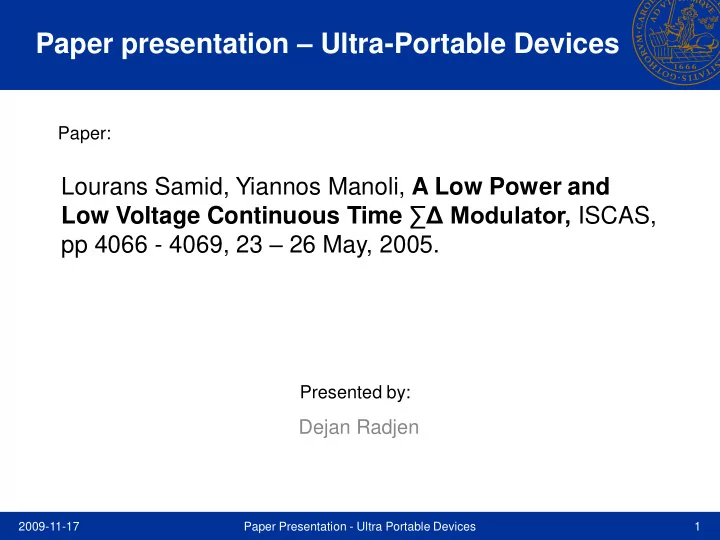

Paper presentation – Ultra-Portable Devices Paper: Lourans Samid, Yiannos Manoli, A Low Power and Low Voltage Continuous Time ∑Δ Modulator, ISCAS, pp 4066 - 4069, 23 – 26 May, 2005. Presented by: Dejan Radjen 2009-11-17 Paper Presentation - Ultra Portable Devices 1
Outline • Introduction to Δ∑ modulators • Continuous Time Δ∑ modulators • Amplifier Requirements • Measurement Results • Summary and Conclusions 2009-11-17 Paper Presentation - Ultra Portable Devices 2
Introduction to Δ∑ modulators 2010-02-08 Paper Presentation - Ultra Portable Devices 3
Introduction to Δ∑ modulators • White noise approximation is accurate if the input signal is changing rapidly and is random • White noise approximation is also more accurate as the number of bits N in the quantizer increases • For a one bit quantizer (a comparator) the white noise approximation is least accurate – but it is used anyway with proper watchfulness • Maximum theoretical SNR for an ideal ADC using white noise approximation: SNR dB = 6.02N + 1.76 2010-02-08 Paper Presentation - Ultra Portable Devices 4
Introduction to Δ∑ modulators Linear model General Δ∑ modulator Using the linear model the output can be written as: Y(z) = STF(z)X(z) + NTF(z)E(z) STF(z) = Signal Transfer Function NTF(z) = Noise Transfer Function 2010-02-08 Paper Presentation - Ultra Portable Devices 5
Introduction to Δ∑ modulators STF = z -1 NTF = (1 – z -1 ) 2 Second order noise shaping • Implementation example of a 2:nd order 1 bit Δ∑ -modulator 2010-02-08 Paper Presentation - Ultra Portable Devices 6
Continuous Time Δ∑ Modulators Modulator Topology Distributed feedback nth order CT- loop filter • Continuous Δ∑ modulators offer implicit anti -aliasing filter 2010-02-08 Paper Presentation - Ultra Portable Devices 7
Continuous Time Δ∑ - Modulators Excess Loop Delay • Excess loop delay τ d is the delay between the quantizer output signal and the DAC output signal 2010-02-08 Paper Presentation - Ultra Portable Devices 8
Continuous Time Δ∑ -modulators Coefficient Mismatch • In DT- Δ∑ modulators the coefficients are given by ratios between capacitors • In CT- Δ∑ modulators the coefficients are decided by RC – time constants with tolerances of ± 30 % • An additional tuning circuit can be added to improve the accuracy of the RC constants • Another method is to use a less aggressive noise transfer function by moving the poles 2010-02-08 Paper Presentation - Ultra Portable Devices 9
Continuous Time Δ∑ - Modulators Coefficient Mismatch a. Without moving the poles b. With moving the poles 2010-02-08 Paper Presentation - Ultra Portable Devices 10
Continuous Time Δ∑ -modulators Clock Jitter Error signal Exponential DAC output signals reduce sensitivity to clock jitter 2010-02-08 Paper Presentation - Ultra Portable Devices 11
Continuous Time Δ∑ -modulators Integrator Implementation Active RC-integrator GmC - integrator 2010-02-08 Paper Presentation - Ultra Portable Devices 12
Amplifier Requirements • Finite DC-gain of the amplifiers cause quantization noise leakage. A rule of thumb is A dc > OSR • Finite Gain bandwidth affects the noise transfer function and can cause instability • Distortion, Slew rate and noise limitations are primarily due to the amplifier in the first integrator • Most power has to be spent on the amplifier in the first integrator 2010-02-08 Paper Presentation - Ultra Portable Devices 13
Measurement Results Measurement Results for the Third Order Continuous Time Δ∑ modulator 2010-02-08 Paper Presentation - Ultra Portable Devices 14
Measurement Results Measurement Results for the Third Order Continuous Time Δ∑ modulator 2010-02-08 Paper Presentation - Ultra Portable Devices 15
Summary and Conclusions • The paper mainly discusses different non idealities present in CT Δ∑ modulators • Continuous time Δ∑ modulators are more suitable for low power design than their discrete time counterparts • The price paid is increased sensitivity to component mismatch, excess loop delay and clock jitter 2010-02-08 Paper Presentation - Ultra Portable Devices 16
Recommend
More recommend